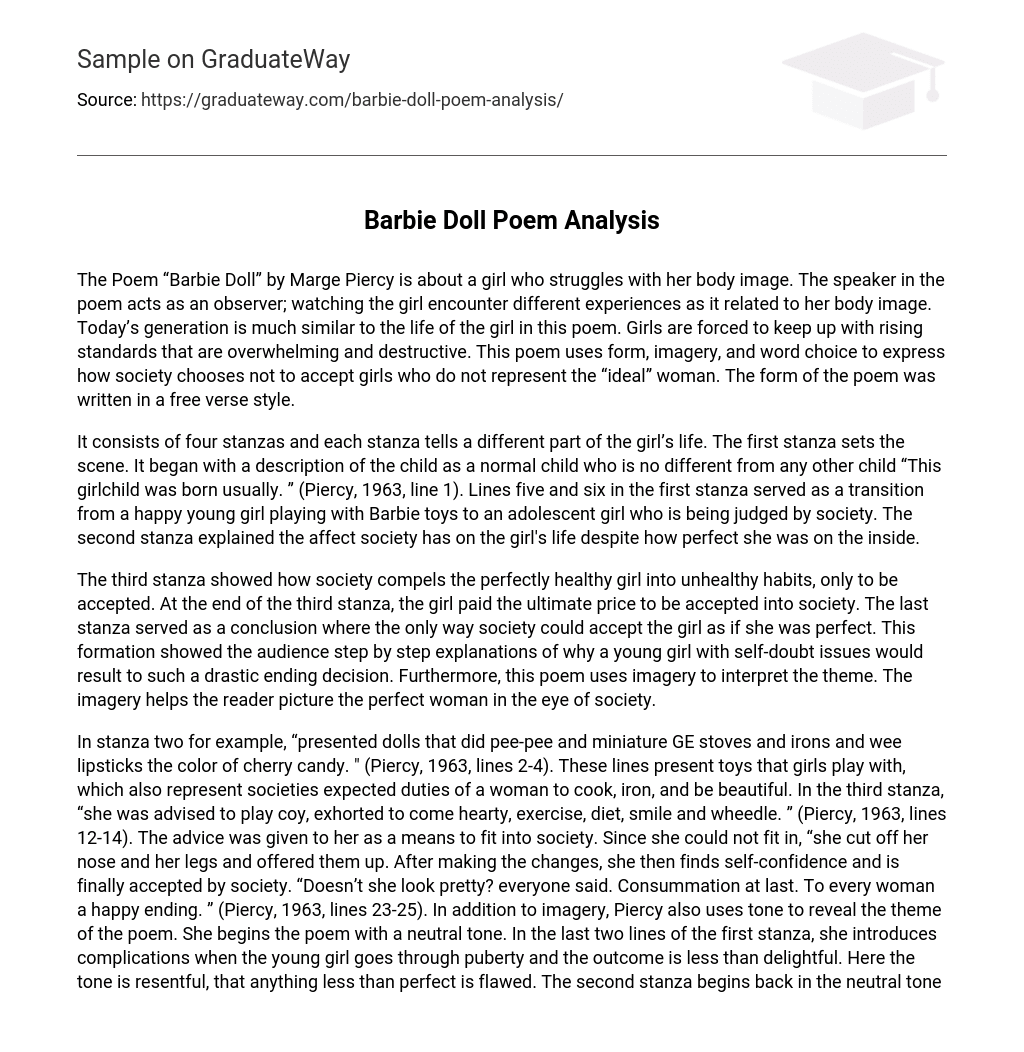The Poem “Barbie Doll” by Marge Piercy is about a girl who struggles with her body image. The speaker in the poem acts as an observer; watching the girl encounter different experiences as it related to her body image. Today’s generation is much similar to the life of the girl in this poem. Girls are forced to keep up with rising standards that are overwhelming and destructive. This poem uses form, imagery, and word choice to express how society chooses not to accept girls who do not represent the “ideal” woman. The form of the poem was written in a free verse style.
It consists of four stanzas and each stanza tells a different part of the girl’s life. The first stanza sets the scene. It began with a description of the child as a normal child who is no different from any other child “This girlchild was born usually. ” (Piercy, 1963, line 1). Lines five and six in the first stanza served as a transition from a happy young girl playing with Barbie toys to an adolescent girl who is being judged by society. The second stanza explained the affect society has on the girl’s life despite how perfect she was on the inside.
The third stanza showed how society compels the perfectly healthy girl into unhealthy habits, only to be accepted. At the end of the third stanza, the girl paid the ultimate price to be accepted into society. The last stanza served as a conclusion where the only way society could accept the girl as if she was perfect. This formation showed the audience step by step explanations of why a young girl with self-doubt issues would result to such a drastic ending decision. Furthermore, this poem uses imagery to interpret the theme. The imagery helps the reader picture the perfect woman in the eye of society.
In stanza two for example, “presented dolls that did pee-pee and miniature GE stoves and irons and wee lipsticks the color of cherry candy. ” (Piercy, 1963, lines 2-4). These lines present toys that girls play with, which also represent societies expected duties of a woman to cook, iron, and be beautiful. In the third stanza, “she was advised to play coy, exhorted to come hearty, exercise, diet, smile and wheedle. ” (Piercy, 1963, lines 12-14). The advice was given to her as a means to fit into society. Since she could not fit in, “she cut off her nose and her legs and offered them up. After making the changes, she then finds self-confidence and is finally accepted by society. “Doesn’t she look pretty? everyone said. Consummation at last. To every woman a happy ending. ” (Piercy, 1963, lines 23-25). In addition to imagery, Piercy also uses tone to reveal the theme of the poem. She begins the poem with a neutral tone. In the last two lines of the first stanza, she introduces complications when the young girl goes through puberty and the outcome is less than delightful. Here the tone is resentful, that anything less than perfect is flawed. The second stanza begins back in the neutral tone, but not as neutral.
The stanza begins with a list of qualities that the girl has, which is everything a “normal” happy girl could have; yet she still did not meet the norms of society. Then the tone changes in the last two lines to express a sense of frustration as the girl feels the need to go through life apologizing for her image. She was not what society expected a girl to look like and she slowly became a victim of society’s expectations. The third stanza is full of aggravation and frustration. The girl is fed up with her image and decides to have plastic surgery done to her nose and her legs.
She then dies but ultimately achieves a happy ending of finally being accepted by society. Through tone, Piercy helped the reader understand the meaning of the poem. In conclusion, it is clear that the poem’s sole purpose is for girls to realize that they do not have to live up to the “ideal” Barbie doll image that society expects them to be. Simply being them and surrounding themselves around the people who will accept them for the whole they truly are, will result in a happy ending.
References
- Piercy, M. (2009). Barbie Doll. In T. R. Arp, & G. Johnson, Perrine’s Literature: Structure, Sound, & Sense, Tenth Edition (pp. 754-755). Boston: Lyn Uhl.





